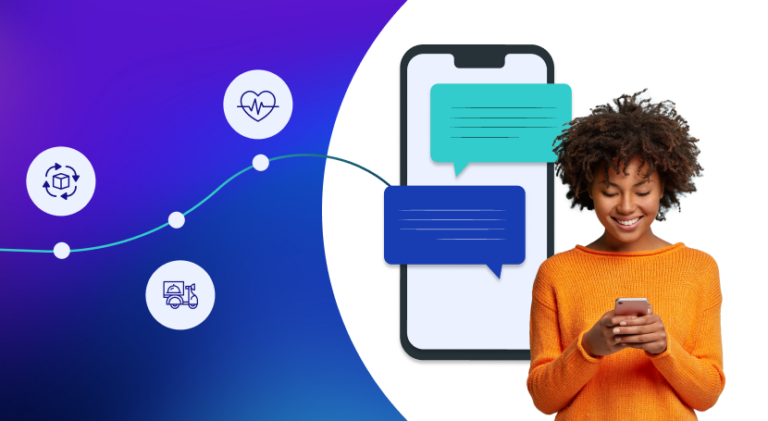SMS for healthcare is transforming the patient experience and creating better outcomes thanks to programmable SMS APIs.
Building an omnichannel strategy to engage with customers is now the norm for businesses. However, too many companies think an omnichannel experience is all about throwing in every available communication channel in the multiverse at their customers, and then calling it a day.
If only things were so simple.
The reality is, building an omnichannel customer experience that your buyers actually want involves deeper understanding of your customer journey touchpoints. And you need to connect all these touchpoints in a seamless way that makes sense to the customer, and genuinely improves their experience of interacting with your business.
When you do this successfully, you will improve customer satisfaction levels, retention rates and boost customer loyalty. An omnichannel customer experience is thus not a ‘nice-to-have’, but a ‘must-have’ if you truly want to differentiate your business.
Let’s dive into some tips on how you can build yourself an omnichannel customer experience that buyers actually want.
1. Understand that omnichannel is not the same as multichannel
Picture this: Your customer emails your customer support team, then makes a phone call and connects with an agent.
In multichannel scenarios, the agent on the phone may not have any details or data about the customer’s previous interaction on the email channel. This siloed state of affairs leads to a disconnected customer experience. The poor support agent is unable to properly look at the bigger picture of WHY the customer is calling in the first place. And as a result, he/she has to ask for the details the customer has already given in the email.
In an omnichannel scenario on the other hand, the agent can see the entire context of the caller’s enquiry by accessing the previous interactions on other channels via a centralised contact center dashboard. With more context, agents can connect the dots and deliver a far smoother customer experience that directly addresses the customer’s needs faster.
Importantly, an omnichannel experience allows customers to effortlessly change to whatever channel they prefer, with no loss of information. The customer experience feels much more connected and seamless as agents can follow the customer’s conversation on whichever channel it happens to be on – no need to backtrack and dig up details the customer provided a month ago.
2. Understand your customers’ preferred channels for different types of enquiries
As the saying goes: different strokes for different folks.
To which we would add, “Different channels for different queries.”

Get monthly nuggets of wisdom for all things customer experience in your inbox
For example, in a Communications Platform as a Service (CPaaS) Roundtable that Toku moderated recently, we learnt that some companies highly value the importance of communicating with customers in a more human fashion, as too much automation meant introducing the risk of inaccuracy and irrelevance. In this specific context where finances are a sensitive matter, companies prefer dedicated human support agents to answer queries via live chat or phone call.
Toku’s Consumer Engagement Report 2022 also found that Singapore consumers ranked Chatbots as their least preferred communication channel with private companies (2%).
Does that mean automation and chatbots have no place in the financial sector?
Hardly! Automated notifications, chatbots and self-service options have helped many financial companies scale their customer support effectively when used for standard and repetitive enquiries, as well as other parts of their workflow. For instance, we happen to know an insurance company that used chatbots to improve their Net Promoter Scores (NPS). The bots would ask if the customer was satisfied with the chatbot experience. And if they are not happy, the insurer would follow up the chatbot with a phone call from a support agent who would help them with any issues.
We can see how this process seamlessly switches from the chatbot to the human agent’s phone call and uses the insights gathered from the chatbot to directly address customer concerns in a targeted yet scalable fashion.
The point is to understand which channels are the most appropriate for specific types of interactions, and then apply them accordingly.
3. Choose a contact centre that supports your omnichannel ambitions
A modern omnichannel contact centre, is a must-have if you want to empower your agents to clearly visualise the customer journey in its entirety, real-time, and respond to customers in a way that elevates the customer experience.
This is because the contact centre is the centre-stage where your supervisors can analyse trends over time, channel by channel. Omnichannel dashboards are superbly designed to cater to the needs of your business by integrating with your CRM, ticketing, and other relevant business tools.
Even as companies rely on automation to improve operational efficiency, human-to-human interaction is still critical to provide the accurate, hyper-personalised support expected by customers. Companies need to identify the right use cases for each communication channel to optimise customer experience at each touchpoint.
On top of this, having the right tech stack like a modern omnichannel contact centre will help you start creating an omnichannel experience your customers will love.
 Nora Huin
Nora Huin 

 Ana Castrillon
Ana Castrillon 
 V K Sanjeed
V K Sanjeed 